Stretching is a form of physical exercise in which a specific skeletal muscle (or muscle group) is deliberately elongated, often by abduction from the torso, in order to improve the muscle's felt elasticity and reaffirm comfortable muscle tone. The result is a feeling of increased muscle control, flexibility and range of motion. Stretching is also used therapeutically to alleviate cramps.
Upper Body

Reaching Stretch

- Interlace your fingers out in front of you at shoulder height.
- Turn your palms outward as you reach forward.
- Hold for 5-10 seconds, then relax and repeat.
Overhead Stretch
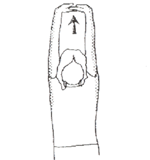
- Interlace your fingers above your head.
- Turn your palms upward as you push your arms back and up.
- Hold for 5-10 seconds, then relax and repeat.
Triceps Stretch

- With arms overhead, hold the elbow of one arm with the hand of the other arm.
- Gently pull the elbow behind your head, create stretch. Move slow.
- Hold for 5-10 seconds.
- Repeat with other arm.
Shoulder Stretch
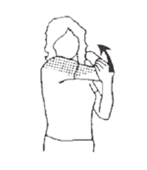
- Gently pull your elbow across your chest toward your opposite shoulder.
- Hold stretch for 5-10 seconds.
- Relax and repeat with other arm.
Chest and Back Stretch
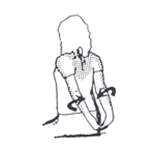
- Clasp your hands behind your back.
- Slowly turn your elbows inward and straighten arms.
- Lift your arms up behind you until you feel a stretch.
- Hold for 5-10 seconds.
Chair Rotation Stretch
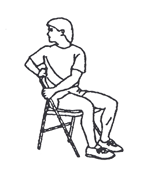
- Sit in chair. Wrap feet around chair legs to stabilize your body.
- Reach across body and grab the back of the chair.
- Pull gently to increase the stretch in the middle of your back.
- Hold 5-10 seconds. Repeat reaching to opposite side.
Spine Tw ist
ist
-
Lying on the floor, place right foot on the left knee. Using your left hand, gently pull your right knee towards the floor, twisting your spine and keeping left arm straight out, hips and shoulders on the floor.
Lower Body
Hip/Glute Stretch

- Cross left foot over right knee.
- Clasp hands behind right thigh and gently pull the leg in towards you, keeping upper body relaxed. Switch legs
Hamstring Stretch
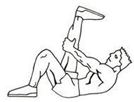
- Lie on floor with knees bent.
- Straighten one leg and slowly pull it towards you, clasping the thigh, calf or ankle.
- Keep knee slightly bent. Switch legs.
Inner Thigh Stretch
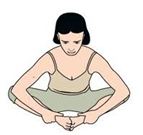
- Sit on floor with feet pressed together.
- Keeping abs in, lean forward until you feel a gentle stretch in your inner thighs.
Lunge Stretch
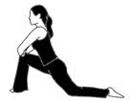
- In lunge position, rest back knee on the floor, with front knee at 90 degree angle, abs in.
- Gently press forward until you feel a stretch in the front of the leg/hip. Switch legs.
Pirifo
 rmis Stretch
rmis StretchBegin on the hands and knees and bring the left knee in, resting it on the floor between your hands (you should be on the outside of the knee).
Straighten the right leg out behind you and, if you can, bend forward and rest the forearms on the floor.
Knees to Chest
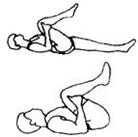
- Lying on the floor, pull your knees into your chest and clasp your hands under your knees.
- Gently press your hips to the floor.
- Can alternate one knee at a time.
Calf Stretch
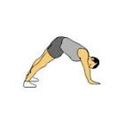
- On hands and knees, straighten your legs, but keep them slightly bent.
- Gently press one or both feet towards the floor, keeping back flat and abs in.
Qu ad Stretch
ad Stretch
 ad Stretch
ad Stretch- Lie down on your side using elbow for balance.
- Using other arm, slowly pull your foot towards your glutes, keeping both knees together and bent knee pointing down. Switch legs.
Lateral Lunges
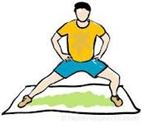
- Begin by standing with your feet shoulder width apart, hands on hips.
- Inhale and step out to the right and shift your body weight over your right leg, squatting to a 90 degree angle at the right knee. Try to sit down with your butt, keeping your back as upright as possible.
- Exhale and push off and bring your right leg back to center to complete one rep. Finish all reps on this side, and repeat on left side to complete one set.
Stretching can strengthen muscles, and in turn strong muscles are important to stretching safely and effectively. Stretching can be dangerous when performed incorrectly. There are many techniques for stretching in general, but depending on which muscle group is being stretched, some techniques may be ineffective or detrimental, even to the point of causing permanent damage to the tendons, ligaments and muscle fiber.



